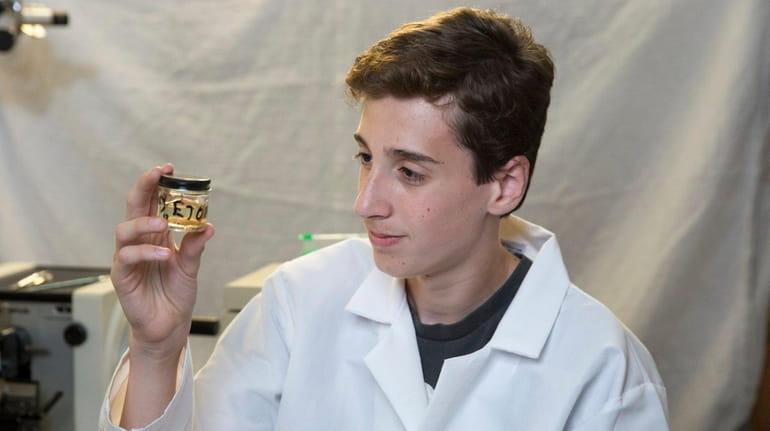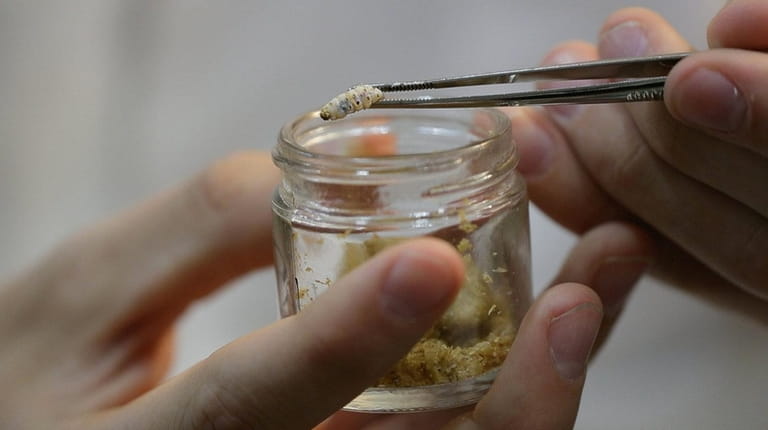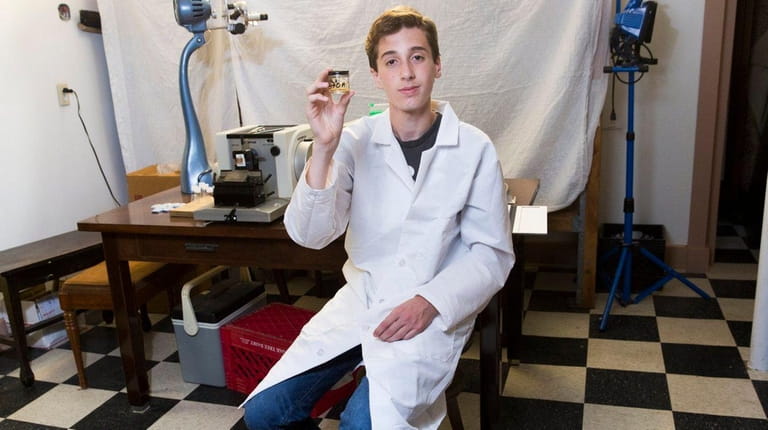Greenport teen Joe McInnis wins award for honeybee research

Joe McInnis, 14, an 8th Grader at Greenport High School, holds a jar of worms that he uses in his research looking into the cause of the collapse of honeybee colonies at a lab in Greenport on Monday, June 6, 2016. Credit: Randee Daddona
A Greenport eighth-grader may have made a break in a case that’s stumped scientists worldwide.
For the past year, Joe McInnis, 14, has been working with retired Plum Island veterinary pathologist Doug Gregg to determine the cause of colony collapse disorder, a global phenomenon in which adult bees disappear from the colony.
McInnis and Gregg suspect iridovirus — a virus that suppresses the immune system — could be infecting honeybees and keeping them from returning to their colonies. The virus, McInnis said, may have an “AIDS-like effect” on the bees, making them more susceptible to common diseases that wouldn’t normally be fatal to them.
“I think this could be earth-shattering information if we’re right. Everybody depends on honeybees to help grow the food that we eat,” said Gregg, who while working at Plum Island treated African swine fever in pigs — a virus similar to the one he’s investigating with McInnis. “Most other people trying to solve this problem are looking at pesticide use. There are very few others who are investigating the possible spread of a virus.”
Colony collapse disorder first cropped up around 2006, according to the U.S. Department of Agriculture. Some scientists have faulted pesticides. Others have pointed the finger at a parasite called the varroa mite that attacks bees, though the cause of the phenomenon is still unclear.
For his research, McInnis became the youngest person to receive a scholarship from the New York State Histotechnological Society. He accepted the $250 grant at an April ceremony in Albany and will use it to purchase research supplies.
“It was really a great honor,” McInnis said. “I never even thought I’d get this far in my project. It’s just great to be recognized.”

Joe McInnis, 14, holds up a jar with wax worms at a lab in Greenport on Monday, June 6, 2016. He is studying the worms as part of his research into the cause of colony collapse disorder. Credit: Randee Daddona
McInnis began his research about a year ago upon the insistence of his science tutor, Bob Jester. Jester, a retired Riverhead High School science teacher, said he immediately knew McInnis was special.
“I could just tell that he was really gifted and exceptionally bright, and just had this urge to try and make sense of the world,” said Jester, who helped connect McInnis with Gregg.
The pair believe waxworms, which are commonly found in honeybee colonies and are particularly susceptible to iridovirus, could be infecting mites that may in turn spread the virus to honeybees.
Currently, McInnis and Gregg are trying to infect their own waxworms with the virus. They’ll then look to see if mites and honeybees can also be infected.

Joe McInnis, 14, an 8th Grader at Greenport High School, holds a jar of worms that he uses in his research into the cause of the collapse of honeybee colonies at a lab in Greenport on Monday, June 6, 2016. Credit: Randee Daddona
“He’s an incredibly bright kid and at 14 years old he’s doing work similar to what would be done by Ph.D. students,” Gregg said, adding that they will probably continue working on the project for two or three more years.
The teen hopes his research someday can help shed light on colony collapse disorder and that eventually his research may be published in a scientific journal.
McInnis will speak about his work at Peconic Landing on June 14 and at the East End Seaport Museum on June 23.
